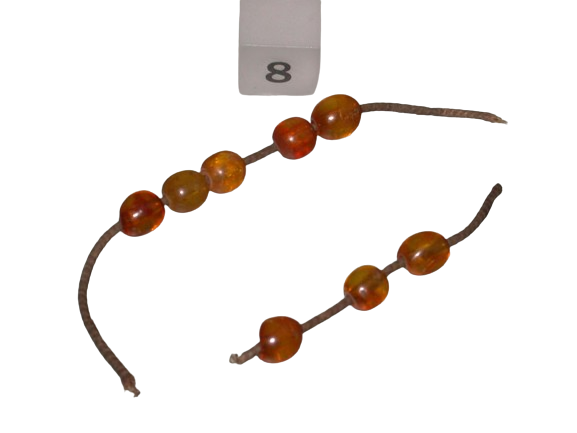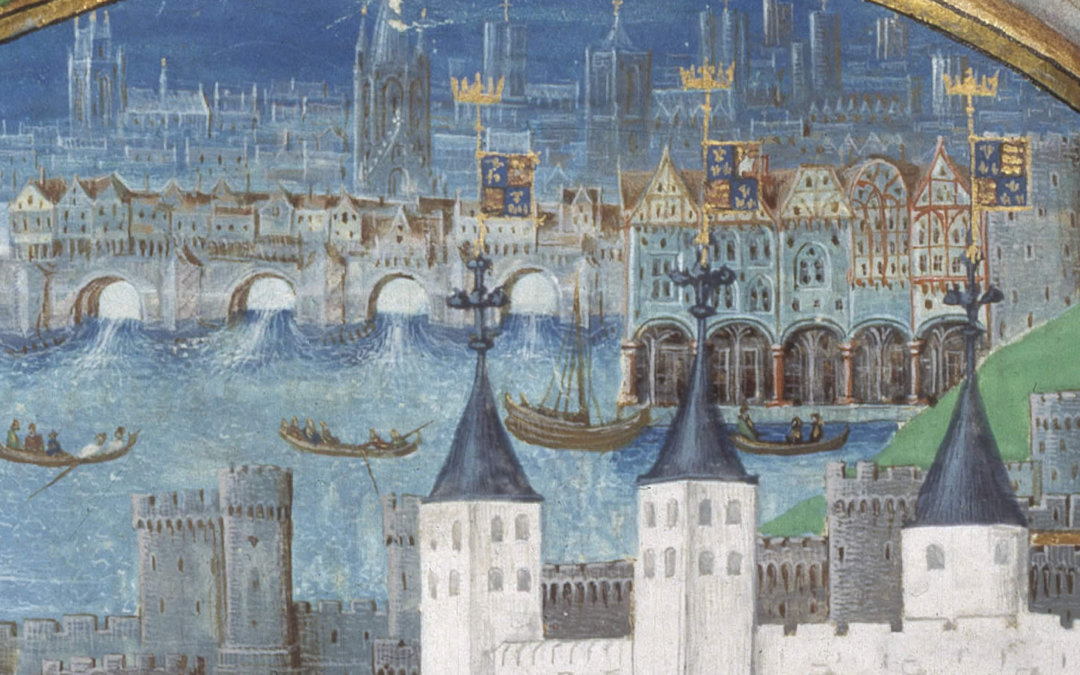The IHR’s Centre for the History of People, Place and Community has been carrying out some exploratory research on the potential of analysing London’s medieval customs accounts digitally. Detailed, or ‘particular’ customs accounts recorded immense detail about the goods and practices of trade, giving an unparalleled insight into the medieval material world and international networks. The challenge of these sources, however, is in their sheer scale, and their complexity. Eliot Benbow has been undertaking proof-of-concept work as part an IHR Internship.
The London customs accounts provide a wealth of information for anyone interested in late medieval material culture. The recent blog by Dr Stephen Gadd has outlined both the great scope but also the technical and practical challenges of utilising Prof. Stuart Jenks’ editions of the customs accounts.[i] I have been working on these documents since October 2019, when Professor Jim Bolton highlighted their usefulness to me. My PhD project, looking at the material culture of lay devotion in later Medieval London was undertaken as a Collaborative Doctoral Award between Queen Mary, University of London and the Museum of London and was planned to be centred around the wide-ranging collections of devotional objects held at the museum. However, the onset of COVID-19 and the subsequent lockdowns meant that access to the museum, and even its detailed catalogues, became almost completely restricted between March 2020 and late 2021. Trawling through the customs accounts therefore became a primary focus for the following two and a half years, allowing me to really appreciate their potential. While I had intended to use them in some form, in many ways they became just as important to my work as study of the objects themselves.
This article illustrates the potential of the London Custom Accounts through one case study of paternosters and beads (or the Middle English “bedes”). Devotional prayer beads are just one example of hundreds of commodities that can be tracked in some form through the accounts. Other traded religious objects I considered in my PhD included carved images, statuettes, paxboards, printed sheets and paper images, painted cloths, holy water stoops, crucifixes and many more.
I built a striking picture by meticulously mining the London customs accounts. At least 660 shipments of paternosters and beads appear in the customs accounts between 1384 and 1537. Astonishingly, over 645 of these shipments are imports; only 12 shipments of beads were exported across all the surviving accounts. This reflects a wider imbalance of trade between imported and exported manufactured goods in later medieval London, something that many London craftspeople bemoaned. Individual shipments could be vast: shipments of beads counted in the 10,000s and 100,000s were regular, and particularly as the fifteenth century progressed. The largest single shipment I have found was a consignment of 600,000 beads imported by the London Haberdasher Henry Somer in November 1494.[ii] Totalling up the collected bead shipments appearing in the Tunnage and Poundage accounts between September 1494 and August 1495, we can find a staggering 1,150,184 imported beads.
There are also intriguing patterns to be found in terms of the merchants who imported these objects . Of around 300 merchants I have discovered importing beads, around 200 were aliens, mostly of Low Countries, Italian or Hanseatic origin, while only around 100 were indigenous London merchants. Amongst the London merchants, around 40 were London Haberdashers, who imported beads alongside the wide range of consumer goods which were their stock in trade.[iii] Due to discrepancies in the types of surviving customs accounts, and the differing groups of merchants who had to pay each type of custom, English trade in these objects is more difficult to follow than that of their alien counterparts. English merchants only had to pay a poundage subsidy as they were exempt from the Petty (or New) Custom on miscellaneous goods. There are substantial gaps in the Tunnage and Poundage accounts, so it is important to remember the ways in which the details of source survival may explain apparent statistical discrepancies.
These mass shipments of beads allow significant insights in terms of material cultural, economic, religious and social history perspectives. Beads were imported in over a dozen materials, from the more expensive varieties of coral, jet, amber and ivory, to the more mundane of bone, wood and glass. Perhaps most importantly, the accounts provide evidence of the mass import of beads of the cheapest materials, which are otherwise totally undocumented. Bone, wood and glass beads seldom appear in other sources used by historians looking at late medieval material culture, such as contemporary wills, because their material value was insignificant.[iv] Therefore the shipments in the customs accounts give us a unique insight into the widespread availability of beads, which would have been available across a much wider social spectrum than previously appreciated.[v]

(© Museum of London)

Museum of London (objects 5079 and BC72[79]<1836>). For an archaeological summary of these amber beads, recovered alongside beadmaking waste during excavations on the site of Baynard’s Castle in 1972: Vanessa K. Mead, ‘Evidence for the Manufacture of Amber Beads in 14th-15th century London’, Transactions of the London and Middlesex Archaeological Society, 28 (1977), 211-214.
14th-15th century.
(© Museum of London)
These large-scale imports speak to a trade that reached far beyond London: they indicate the scale of growth in distributive trade in fifteenth century England.[vi] Many of the London Haberdashers who imported large shipments of beads provided credit to regional merchants and chapmen across much of England, and the sizes of these shipments suggest that they supplied goods as well. These trends are usually associated with the seventeenth century and the Consumer Revolution of the eighteenth century.[vii] The data I have collected suggests that the root of these developments can be traced from the London customs accounts, through to the records of Court of Common Pleas, where many London Haberdashers lodged debt cases against chapmen.[iix] Many of the most prolific litigants were the same merchants who imported bulk shipments of commodities like beads.[ix]
Compiling this data has been time consuming work. The availability of the accounts in PDF form has made a huge difference, compared to combing through the original documents at the National Archives (this PhD would not have been possible without the access to the PDFs). However, the editions are replete with complexities and nuances. For most commodities a simple Ctrl-F search will not get you that far. Using the copious indexes provided by Prof. Jenks is an excellent starting point, but even these must be considered alongside complexities of terminology, of name differences, of scribal spelling conventions, and a gradual anglicisation of the accounts that occurs through the fifteenth century. In the end, the best way to go through the accounts in many instances was to read line by line, page by page, compiling endless Word documents and spreadsheets. A more accessible means of using these documents will be essential for researchers to make the most of the rich information they contain.
[i] This can be seen as part of a wider series of interrelated developments in trade and distribution that Stuart Jenks has termed as the “Distribution Revolution” of the fifteenth century. Stuart Jenks, ‘The Missing Link: The Distribution Revolution of the 15th Century’, in Angela Ling Huang and Carsten Jahnke, eds., Textiles and the Medieval Economy: Production, Trade and Consumption of Textiles, 8th – 16th Centuries, Ancient Textiles Series, 16 (Oxford, 2015), pp. 230-252.
[ii] The classic study being, Margaret Spufford, The Great Reclothing of Rural England, Petty Chapmen, and their Wares in the Seventeenth Century (London, 1984).
[iii] This follows from important work done by Sylvia Thrupp, Derek Keene and James Galloway: Sylvia Thrupp, ‘The Grocers of London, A Study of Distributive Trade’, in Eileen Power and M.M. Postan, eds., Studies in English Trade in the Fifteenth Century (London, 1933), pp. 247-292; Derek Keene, ‘Changes in London’s economic hinterland as indicated by debt cases in the Court of Common Pleas’, in James A. Galloway, ed., Trade, Urban Hinterlands and Market Integration (London, 2000), pp. 59-82; James A. Galloway, ‘Reconstructing London’s Distributive Trade in the Later Middle Ages: the role of Computer-Assisted Mapping and Analyses’ in Matthew Woollard, ed., New Windows on London’s Past: Information Technology and the Transformation of Metropolitan History (Association for History and Computing (2000), pp. 1-24.
[iv] Much of my early work on this area has been assisted by the Anglo American Legal Tradition indices of Court of Common Pleas cases: AALT CP40 Indices, http://aalt.law.uh.edu/Indices/CP40Indices/CP40_Indices.html [Accessed: 30/01/2024].
[v] Stuart Jenks ed., The London Customs Accounts, Quellen und Darstellungen zur hansischen Geschichte. Neue Folge, Volume 74, Parts 1-4 (Lübeck, 2016-Present). The completed series will total forty-five volumes and are fully digitised and open access: https://www.hansischergeschichtsverein.de/london-customs-accounts?seite=1 [Accessed: 30/1/2023].
[vi] Jenks, ed., London Customs Accounts, 4:3 (Lübeck, 2017), p. 103. Somer also imported 12 latten crucifixes, 12 dozen printed primers (books of hours) and 300 “printid bokes” as part of a cargo in March 1495: Ibid., p. 163. Somer (d. 1502) had an interesting and extensive mercantile career which culminated in being appointed sheriff of London in 1494-95. In his PCC will of 1502 he left a large “mast” of coral, which probably would have been used either for bead making or as a fancy domestic ornament: TNA PROB 11/13/313.
[vi] For a good introduction to the development of the Haberdashers in later medieval London: Ian W. Archer, The History of the Haberdashers’ Company (Second edition: Chichester, 2017), pp. 1-52. Much more work could be done, however, on the company’s earlier members, particularly those of the later fourteenth – early sixteenth centuries.
[viii] For excellent recent work on the presence of devotional objects in the wills of late medieval Londoners: Katherine L. French, Household Goods and Good Households in Late Medieval London (Philadelphia, 2021), particularly pp. 190-216.
[ix] The archaeological record provides more diverse evidence for the ranges of beads used by medieval Londoners. Geoff Egan and Frances Pritchard, Dress Accessories c.1150-c.1450, Medieval Finds from Excavations in London, 3 (Second edition: Woodbridge, 2012), pp. 305-317.


